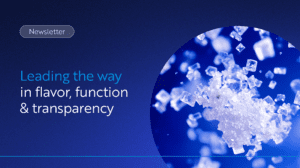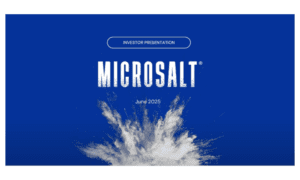Discover the meaning of “stealth sodium” and which foods high sodium most commonly lurks in.
Key Takeaways:
- Many popular foods are giving Americans more sodium than they’re aware of
- The average American consumes over half again the recommended daily sodium limit
- A stealthy reduction of sodium in the manufacturing process may help salt-loving consumers accept lower levels
Salt, like sand, seems to get everywhere. This is a major health problem for Americans, particularly those with sodium sensitivity. CDC data confirms that Americans two years and older consume a daily average of 3,400 mg of sodium – far more than the recommended maximum of 2,300 mg per day and a contributor to many potentially fatal chronic conditions.
It isn’t only inattentive eaters who are at risk. Even for the most conscientious consumers, monitoring sodium intake is difficult because of “stealth salt” – a problem created by a lack of manufacturer transparency and public awareness. Read our guide to learn where sodium may be sneaking into your diet and how you can avoid it.
The salty six and stealth salt
It’s safer not to assume that everyone knows what the “salty six” is. They may be the most common contributors to sodium in the American diet, but that doesn’t mean they’re on every shopper’s watch list. These foods are:
- Soups
- Cured meats and cold cuts
- Pizza
- Breads
- Sandwiches
- Tacos and burritos
There are other, lesser-known sodium threats (let’s call them the “furtive five”) that could also increase your risk of consuming stealth salt:
- Snacks and frozen dinners
- Canned vegetables
- Sauces
- Condiments
- Cheese and buttermilk
Avoiding stealth salt requires checking food and drink labels and tallying their per-serving sodium content. Keep in mind that aiming for the recommended daily maximum of 2,300 mg isn’t as healthy as going for 1,500 mg, which is recommended as a safe and healthy average.
The next step in stopping stealth salt is recognizing how food manufacturers phrase sodium content. Read our guide on decoding sodium labels to speak this hidden language and discover how “sodium-free” doesn’t always mean sodium-free!
Salt substitutes and ordering without asking
Be wary of substituting traditional table salt, such as sea salt or pink salt. Sea salt doesn’t offer any less sodium. Pink salt does, but it also comes with caveats like potentially toxic elements such as arsenic and lead.
You can also look more closely at how much sodium fast-food vendors have in their menus. This isn’t always easy to see, and big chains like McDonald’s and Burger King don’t go out of their way to publicize them. Our earlier blog spotlighted these figures and offered suggestions on some of the lower-sodium options they provide.
Ask about sodium content wherever you eat out and think twice about ordering if they can’t provide this information. At the very least, the vendor can accommodate you by not adding extra salt during preparation.
The human body generally requires only 500 mg of sodium per day to function optimally. However, this figure varies between individuals based on lifestyle and health status. Always consult your doctor about the “right” intake of sodium for you. Raising awareness of sodium in our diet is a big step toward a healthier lifestyle. However, not every form of sodium we consume comes from food or drinks.
Stealth sodium in medicine
Over-the-counter and prescription drugs are supposed to keep us healthy, but they can also have high sodium levels. This is deliberate in some cases, such as with potassium chloride pills or loop diuretics used to treat hyponatremia (low sodium levels). In many other cases, this ingestion of excess sodium is not intentional.
A single table of Alka-Seltzer Plus contains 476 mg of sodium – 20.6% of the recommended daily maximum. 500 mg of acetaminophen like Tylenol may have 390 mg of sodium in its soluble form and 440 mg in its effervescent form. This was revealed in one study that also associated such products with an increased risk of cardiovascular disease and mortality. This is supported by further research published this year that connects sodium-containing medications to adverse health outcomes.
Ask your doctor or pharmacist to help you identify how much sodium is in your medication. Training yourself to read the label of everything that goes into your body makes it harder for stealth sodium to affect you.
Tastebuds can be trained, but this takes time
Tastebud training is another practice food manufacturers have been relying on to help consumers slowly adjust to less sodium in their diets. Taste adaptation can result in a 30% reduction in sodium intake and a higher tolerance for low sodium for some individuals; however, a preference for saltier foods may remain. Modern technology has a better and faster way to reduce sodium content and maintain a full salty flavor without subjecting consumers to gradual or unpleasant change.
MicroSalt® – the right kind of stealth sodium
Sneaking too much sodium into people’s diets is stealthy and unhealthy. Sneaking it out while retaining the salty taste people love is a much healthier approach. Food manufacturers can add all-natural MicroSalt® to their production process to deliver twice the taste of traditional salt while using 50% less sodium.
It has no added salt substitutes and no potassium chloride – a common substitute for sodium chloride that has been linked to harmful health effects, particularly for those already taking potassium chloride medications.
Consumers can also try our SaltMe®! Chips, which are widely available and provide an excellent, flavor-packed alternative to high-sodium snacks or other low-sodium chips that are bland and tasteless. And they can refer to our quick guide on 11 tasty snack choices that can dramatically reduce sodium consumption!
Contact us today with any questions
Our mission is helping to create a world where good health doesn’t come second to great taste. MicroSalt® is the proud global winner of the P&G Alumni Network’s 2021 Star Entrepreneur Award. We’re here to help make products and lifestyles the healthiest they can be. Simply contact us via our message page, connect with one of our international offices, or call 1 (877) 825-0655 to learn more.




